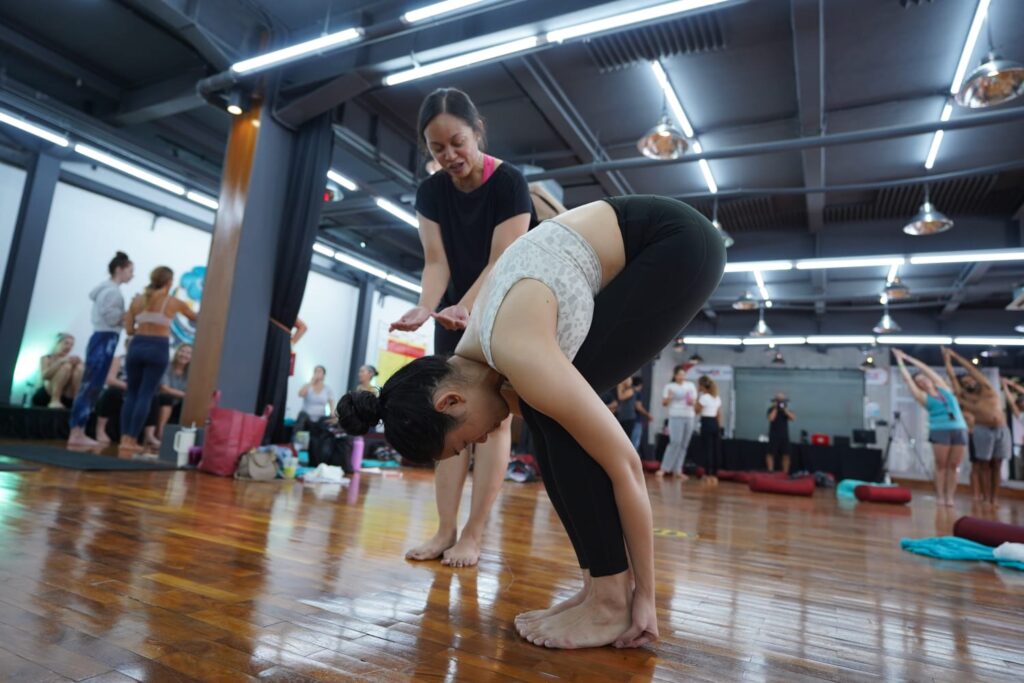Transitioning to a full-time career teaching yoga can be one of the most fulfilling and life-changing decisions you’ll make.
With the right preparation, yoga teaching can be both rewarding and financially stable. Yoga has gained widespread popularity, and the demand for qualified instructors has never been higher.
Many yoga teachers find opportunities at yoga studios, gyms, and even corporate wellness programs. As a result, more people are considering leaving their traditional jobs to pursue yoga teaching professionally. However, before making the leap, it’s essential to build a strong foundation.
Here are seven essential steps to prepare for a stable and rewarding yoga teacher career.
Step 1: Define Your Goals and Vision for a Career Teaching Yoga
Before diving into a full-time career teaching yoga, take the time to clarify what you want to achieve. Teaching yoga can offer a flexible and fulfilling career, but knowing your “why” is crucial to staying motivated.
Are you drawn to teaching because you want to make a difference in others’ lives? Do you want a flexible job that allows you to work from anywhere? Do you aspire to lead specialized workshops or retreats in yoga studios?
Setting clear, achievable goals will help guide your career decisions. For example, start by aiming to teach a certain number of classes weekly, building a private client base, or finding a niche within yoga that aligns with your interests.
Visualizing the type of yoga teacher career you want is a powerful tool that will help you make informed decisions as you build momentum.
Step 2: Get Certified and Choose Your Specialization in Your Yoga Career
Becoming certified is essential for credibility, professional growth, and job opportunities as a yoga teacher. A reputable certification, like the Yoga Alliance’s RYT-200 or RYT-500, not only provides foundational skills but also opens doors to better-paying positions and establishes your standing in the yoga community.
A career teaching yoga relies on strong skills in anatomy, physiology, teaching methodology, and practical experience.
All of which a certification provides.
There are many different styles and specializations within yoga, such as Vinyasa, Bikram, Ashtanga, and Yin yoga, each with its own unique teaching approach. Specializing in one of these styles can help you stand out and potentially earn more, especially if you want to work with reputable yoga studios.
For those interested in niche areas, certifications in prenatal, kids, or therapeutic yoga can also be beneficial and offer unique opportunities within the industry. Choosing the right specialization will align your certification with your long-term goals and vision for a sustainable career teaching yoga.
Step 3: Start Teaching Part-Time to Build Your Career Teaching Yoga
One of the best ways to build experience while minimizing risk is by teaching yoga part-time. This approach allows you to gain hands-on experience, establish a student following, and test out your teaching style without fully relying on yoga for income yet. You’ll develop confidence and refine your skills in classroom management, cueing, and adapting sequences for different levels.
Look for opportunities to teach community classes, volunteer at local yoga studios, or assist experienced instructors. This hands-on experience is invaluable in building your yoga teacher career. Gather feedback from students and mentors to continuously improve your teaching style.
Teaching part-time also enables you to test your market and build a student following, which will support you when you eventually transition to full-time teaching. The experience you gain during this phase will become a foundation for your long-term career teaching yoga.
Step 4: Build Your Personal Brand for a Career Teaching Yoga
In the yoga industry, personal branding and networking play a huge role in a successful career teaching yoga. Building a unique teaching style and strong personal brand is essential for establishing yourself and attracting a loyal student base.
A well-defined brand allows you to communicate what makes your classes distinct and why students should choose you. This brand can be reflected in your teaching style, communication, and the type of experience you create for students.
Create an online presence through social media platforms like Instagram or Facebook, where you can share yoga tips, wellness advice, and class updates. Consider building a website where potential students can learn about you, view your class schedule, and contact you for private sessions or workshops.
Networking within the yoga community by attending events, workshops, and retreats will help you connect with other teachers, yoga studios, and potential students. Collaborating with others in the community can lead to teaching opportunities, mentorship, and partnerships, all of which can strengthen your career teaching yoga.
Step 5: Diversify Income Streams in Your Career Teaching Yoga
A sustainable career teaching yoga often requires multiple income sources. In addition to studio classes, consider offering private lessons, which often allow for more personalized guidance and higher rates. Many yoga instructors also branch out into personal training to complement their yoga offerings and create additional income opportunities.
Workshops and retreats are other excellent ways to boost earnings and connect with students on a deeper level. Many yoga teachers find that retreats are a valuable way to build strong relationships with students while also providing a more immersive experience.
Online teaching has also become increasingly popular, allowing you to reach a global audience and offer classes or membership subscriptions for recorded and live classes. Consider creating passive income through digital products, such as recorded yoga sessions, e-books, or branded merchandise.
Each of these options allows you to diversify income while sharing your knowledge and building your career teaching yoga. Diversifying income helps ensure financial stability and provides flexibility for times when class attendance or schedules fluctuate.
Step 6: Assess Financial Readiness for Transitioning to a Career Teaching Yoga
Before quitting your day job, evaluating your financial readiness is essential. Begin by determining your monthly income needs to cover personal and professional expenses.
Then, set a goal to save enough to support yourself during slower periods or as you build your teaching hours and client base.
A realistic financial plan will ease the transition and help you avoid financial stress when starting your career teaching yoga full-time.
Create a transition plan by setting a timeline and budget. Start by reducing expenses and increasing your savings, then gradually increase your teaching hours until they match your financial goals.
Consider creating a financial cushion to account for potential fluctuations in income, especially as you establish yourself.
This preparation ensures a smoother transition and allows you to start your yoga teacher career with confidence and stability.
Step 7: Take the Leap and Commit to Your Career Teaching Yoga
When you’re financially and professionally ready, it’s time to take the leap with confidence. Start by securing regular classes or clients and finalizing your teaching schedule to maintain a consistent income.
Self-employment in yoga teaching can be challenging, but staying organized, disciplined, and focused on your goals will keep you moving forward.
The journey to becoming a full-time yoga teacher is incredibly rewarding, and the freedom to shape your career is empowering. Over time, as you establish yourself, continue to invest in your growth and network with others in the industry.
Attending advanced trainings, workshops, and yoga conferences can help you refine your skills and remain inspired in your career teaching yoga. With dedication and consistency, you can make a long-lasting impact on your students’ lives while thriving professionally.
Frequently Asked Questions (FAQs)
1. How much can a full-time yoga teacher expect to earn?
Earnings vary based on location, experience, and class frequency. On average, yoga instructors can earn between $20-$50 per hour for studio classes, with higher rates for private sessions and specialized workshops.
2. Do I need to be a full-time teacher to make a good income in yoga?
No, many teachers earn well through diversified income streams, like workshops, retreats, online classes, and private sessions, without needing to commit to a full-time teaching schedule.
3. Is online yoga teaching profitable?
Yes, online yoga teaching can be profitable, especially as it allows for scalable income through recorded classes, live sessions, and membership subscriptions. It also offers flexibility to teach from anywhere.
4. What is the typical cost of a yoga teacher certification course?
Certification programs typically range from $1,000 to $3,000 for a 200-hour program, with advanced and specialized programs costing more. This investment is crucial for a reputable career teaching yoga.
5. How can I attract students when I’m just starting?
Focus on building a strong online presence, networking within the yoga community, offering community classes, and developing a personal brand that reflects your unique teaching style.
6. Can I teach yoga without a certification?
While it’s possible in some locations, a certification is generally required for credibility and better job opportunities, especially if you plan to work with studios or wellness organizations.
7. How long does it usually take to establish a full-time yoga career?
Building a stable income in a yoga teacher career can take 1-2 years, depending on how much time you dedicate to teaching, marketing efforts, and the diversity of services you offer.
Conclusion
Transitioning to a career teaching yoga can be deeply rewarding if you prepare each step thoughtfully. With the right approach, you’ll soon be able to thrive in a profession that aligns with both your passion and financial goals. If you’re interested in further specialization, consider our Hot Yoga Teacher Training program.
It’s a comprehensive way to gain expertise and build confidence, providing a strong foundation for a successful career. With thorough preparation, your dream of teaching yoga full-time can become a sustainable and fulfilling reality.



